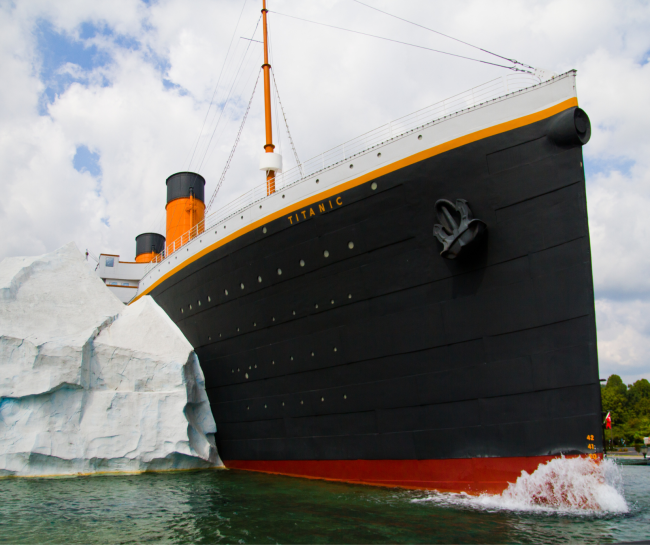The Real Cause Of Titanic Sinking
For over a century, the story has remained unchanged – the unsinkable Titanic met its tragic end after colliding with an iceberg. But what if there’s more to the story? Maybe the iceberg is not the real cause of the Titanic Sinking.
What if a very rich man orchestrated the whole disaster to eliminate his rivals? What if it was not an iceberg, but a bomb that caused the mighty ship to flounder?

The Iceberg Is Not The Real Cause of Titanic Sinking?
Follow us as we take a deep dive into the icy waters of the past, re-examining one of history’s most infamous disasters – the sinking of the Titanic!
1. The Story of an Armenian Witness
Aged just 25 in the spring of 1912, Vaghinak Byurat boarded the Titanic with a mission to transport a collection of books that he and his renowned writer father had published.
Vaghinak’s journey to the ill-fated ship began in Istanbul, as he navigated the legendary Oriental Express to reach Southampton. Overwhelmed with anticipation, he arrived on the departure day, blending in with the crowd. Aboard the Titanic, he found companionship in three men who shared cabin 804 with him – two Englishmen and a French gentleman from Alsace, Moren. The bond between Vaghinak and Moren was particularly strong, owing to their similar ages and shared linguistic ability in French. Together, they spent their time aboard the “unsinkable” ship exploring the deck, saloon and bar, completely oblivious to the impending disaster.
The night of April 14 brought their casual camaraderie to a chilling halt. An abrupt explosion-like sound jolted them awake. Instinctively understanding the severity of the situation, Vaghinak and Moren grabbed a few essential items and left their cabin.
Their shared understanding of the disaster deepened when they observed the crew preparing the lifeboats. Prioritizing women and children, the crew were turning away men. Vaghinak and Moren were now faced with a life-altering decision. They could either resign themselves to a dismal fate aboard the sinking ship, or they could take a leap of faith into the freezing ocean. They choose to jump.
In the cold, dark ocean Vaghinak lost his buddy, as he was battling the freezing temperatures himself, losing all hope of surviving.
However, in an unexpected twist of fate, Vaghinak found himself aboard another ship, the Carpathia, among the survivors of the Titanic disaster. He had been rescued by a woman named Missis Astor who had compassionately claimed him as her son and convinced the lifeboat crew to pull him aboard.
After his recovery, he was able to reunite with his family in Boston. He went on to live a long and fulfilling life, often telling his unique story. A notable aspect of his narrative was his firm belief that an explosion, not an iceberg, was the cause of the Titanic’s sinking. He never could definitively explain what caused the explosion – whether it was a fire in the ship’s hull or perhaps a German U-boat attack. These details remain a part of the enduring enigma that is the Titanic’s tragic end.
Of course, you should take this story with a grain of salt. Its underlying message is that the Titanic might have sunk because of a man-made explosion and not an iceberg.
2. Could it have been a German U-boat?
There is, indeed, an intriguing theory proposing that the ill-fated ship’s end was caused by a German submarine.
This unconventional theory, if validated, would position the Titanic’s demise as a prelude to the infamous destruction of the Lusitania in 1915. The Lusitania, a British ocean liner, was torpedoed off the coast of Ireland by a German U-boat, resulting in a loss of 1,198 lives.
Despite the lack of extensive supporting evidence, this theory cannot be entirely discounted and continues to fuel people’s imagination.
Several Titanic survivors claimed to have observed an unidentified vessel approximately five to six miles away as their ship sank.
This mysterious vessel, which allegedly remained in the vicinity until 2 a.m., could potentially have been a submarine that had surfaced to assess the damage it had caused. The Survivors’ testimonies also included several explosive sounds emanating from deep within the Titanic.
True or not, this theory surely adds another layer of mystery to the Titanic’s tragic downfall.
3. Millionaire Banker J.P. Morgan planned it all
According to this wild theory, J.P. Morgan supposedly plotted the entire Titanic catastrophe to eliminate his financial rivals, namely Jacob Astor, Isidor Straus, and Benjamin Guggenheim. All of whom, as it happened, died aboard the ill-fated vessel.
Now, here’s the kicker: Morgan had initially planned to be on the Titanic’s maiden voyage himself, but he conveniently cancelled his trip just before departure. But as eyebrow-raising as that is, the theory struggles to explain how Morgan could have manipulated the ship into striking an iceberg, resulting in the death of over 1,500 people, including the three rivals he supposedly targeted.
And, here’s where it gets even murkier. The theory proposes that Morgan orchestrated this disaster because these men were opposed to the creation of the Federal Reserve. However, records show that Astor and Guggenheim never publicly opposed it, and Straus was actually in favor of it!
But hold up! There are even more spicy twists to this story. Alternate versions suggest that it wasn’t Morgan but the powerful Rothschild banking family or even the Jesuits who orchestrated the untimely demise of Astor, Straus, and Guggenheim on the Titanic.
However, considering the Rothschilds global conspirators is a tired and harmful theory that dates back centuries. And, it’s based more on anti-Semitism than any grounded historical facts. So, unlike the Titanic, this theory doesn’t hold too much water either. See what we did there?
4. The Titanic Didn’t Really Sink
Waait, what? Wait until you hear it all.
A popular belief among conspiracy enthusiasts is that the Titanic was switched with its sister ship, the R.M.S. Olympic, as part of an elaborate insurance fraud scheme.
The story begins when the Olympic, on a voyage from Southampton, England to New York in September 1911, suffered significant damage and had to be taken back to Harland and Wolff’s shipyard in Belfast for repairs. After repairs, it successfully completed its journey to New York and back. The Olympic was again in Belfast for further repairs in March 1912, just before the Titanic’s fateful maiden voyage.
Here’s where the conspiracy theory comes in: it suggests that the Olympic’s damage was so extensive that it was deemed unprofitable. According to this tale, someone switched it with the Titanic to intentionally sink the problematic ship, cash in on the insurance payout, and, it seems, cause a catastrophic loss of life in the process.
However, this theory is riddled with flaws, the most glaring being that the insurance coverage on the Titanic would not have fully compensated for the loss of the Olympic.
And more than that, how do you switch two huge ships in a gigantic port without anyone noticing? Just how?
5. ”NO POPE”
Now you might be asking, “Have you gone mad?”. Wait till you hear all of it.
So, the Titanic’s hull number was 3909 04. Some of the shipbuilders, who were supposedly Catholic employees at Harland and Wolff in Belfast, were alarmed because this number appeared to spell out “NO POPE” when seen in a mirror. Now, that’s a chilling omen if you’re a devout Catholic, right?
Imagine this – a catholic shipyard worker spotted the mirrored “NO POPE” in a puddle after a downpour. He jotted down and called the others to take a look. All of them were scared at the dire message – “NO POPE”
For the devout Catholic workers of Belfast, this stirred up a deep-seated resentment. Tensions rose until representatives from the management assured them that it was all a coincidence, with no ill intent behind it. Yet, despite the reassurance, working on the ship resumed with a shadow of dread hanging over them. For many of them, the hull number was a bad omen.
However, the idea that Catholic workers at Harland and Wolff would have been spooked is a bit off. The company was notorious for its absence of Catholic workers since the late 1800s.
Despite the facts, Paul Burns, from the Titanic Museum Attractions in Missouri and Tennessee, says that every now and then, a visitor will inquire about this enduring myth.
6. The Titanic floundered because of a cursed mummy
It seems that the grand Titanic, the ‘unsinkable’ ship, wasn’t just carrying the world’s wealthiest and most influential people on its maiden voyage. Hushed whispers spoke of a chilling secret stowed deep within the ship’s hull. An ancient Egyptian princess, mummified in the glory of her time, had allegedly found her way into the Titanic’s cargo, bringing along with her a fearsome curse.
The story goes that ever since she had been excavated from her eternal rest and transported across the English Channel, she had left a wake of destruction and calamity behind her. The princess, it seemed, was not pleased with her new surroundings and wanted to see the Titanic on the bottom of the Atlantic. But what happened to the mummy then?
Does she like the icy waters and dark abyss of the ocean? Who knows
7. It was the perfect storm
Picture this: a smoldering fire in the depths of the ship, an iceberg lurking in the pitch-dark Atlantic night, and a series of oversight and negligence from those in charge. Senan Molony, a seasoned Irish journalist and author, suggests that these three factors could have conspired to bring about the untimely end of the ‘unsinkable’ ship.
Let’s delve deeper into the heart of this theory, shall we? Hidden away in the belly of the Titanic, in Bunker Number 6, a fire was supposedly raging even as the ship left the docks. Molony proposes that this persistent blaze could have gradually weakened the ship’s steel hull.
So when the unsuspecting Titanic made its fatal encounter with the iceberg, its hull – already compromised by the relentless heat – just couldn’t withstand the impact. A catastrophic failure was all but inevitable.
What’s truly intriguing here is that the role of the fire wasn’t entirely dismissed in the original inquiry into the disaster. Sure, it didn’t receive the limelight it probably deserved, but it wasn’t entirely brushed under the carpet either.
So, folks, the ‘perfect storm’ theory gives us yet another perspective on the tragic demise of the Titanic – a dramatic blend of fire, ice, and human negligence. Makes you think, doesn’t it?
